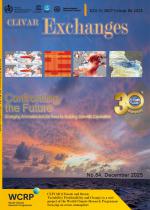CORE-II simulations: An assessment of the Indian Ocean annual and seasonal mean states

Figure 1: Annual mean transport across the equator from MOM, MOM025, KIEL, KIEL025, all model ensemble and ORAS4. Units are in m2/s.
Although the increasing availability of observational data in Indian Ocean under the Indian Ocean observing system IndOOS program , a comprehensive analysis of the basin-scale oceanographic features for the Indian Ocean from multi-model has not been documented. There are examples of a number of successful inter-comparison activities for the Pacific, Atlantic, Arctic, and Southern Oceans (Tseng et al., 2017, Danabasoglu et al., 2014, Danabasoglu et al., 2016, Farneti et al., 2015, Ilicak et al., 2016). Following the Coordinated Ocean-ice Reference Experiments (CORE) interannual protocol (CORE-II), scientists from the Ocean modeling community have analyzed the annual and seasonal mean characteristics of the Indian Ocean circulation and water masses from 16 global ocean-sea-ice model simulations. The analysis was published in the CORE-II virtual issue of Ocean Modelling journal.
Figure 2: Seasonal cycle of SST over the Eastern Equatorial Indian Ocean from (a) CORE-II simulations (c) CMIP5 simulations. The model ensemble mean and observed SST are also shown as dashed thick gray and blue lines, respectively. (b) Seasonal cycle of net heat flux from all the CORE-II simulations as well as two observations (NOCS and TropFlux in dashed thick red and black lines, respectively). (d) Seasonal cycle of CORE-II and CMIP5 ensemble mean and NOAA-OI SST (left axis) and net heat flux (NHF) from CORE-II simulations and observations (NOCS and TropFlux; right axis). The legend for individual models is the same in panels a and b.
With these simulations especially in the models with realistic topography, scientist uncover a secondary pathway of northward cross-equatorial transport along 75 °E, which was unidentified before. When simulating the salinity profiles in the upper ocean, the geopotential (level) models show a better performance than isopycnal models. Comparison of forced simulation with coupled model simulation suggest that biases are reduced in CORE-II forced simulations, thus the origin for the coupled biases is mostly related to coupled feedbacks that amplify ocean and atmospheric biases. Coupled model shows large inter-model spread over the eastern equatorial Indian Ocean. The study shows that refinement in model horizontal resolution (one degree versus 1/4 degree) does not significantly improve simulations, though there are some marginal improvements in the salinity and barrier layer results. The results in turn suggest that a focus on improving physical parameterizations (e.g. boundary layer processes) may offer more near-term advances in Indian Ocean simulations than refined grid resolution. Despite the successfully simulation in the large-scale tropical current system, models are unable to capture the observed thick barrier layer in the north Bay of Bengal.
The CLIVAR Ocean Model Development panel contributed this work.
(Summary written by Rahaman)
*****************************************************************************************
An assessment of the Indian Ocean mean state and seasonal cycle in a suite of interannual CORE-II simulations
H. Rahaman, U. Srinivasu, S. Panickal, J.V. Durgadoo, S.M. Griffies, M. Ravichandran, A. Bozec, A. Cherchi, A. Voldoire, D. Sidorenko, E.P. Chassignet, G. Danabasoglu, H. Tsujino, K. Getzlaff, M. Ilicak, M. Bentsen, M.C. Long, P.G. Fogli, R. Farneti, S. Danilov, S.J. Marsland, S. Valcke, S.G. Yeager, Q. Wang
The details of the study are available at
https://www.sciencedirect.com/science/article/pii/S1463500319301118#b18











Add new comment